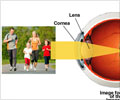Soft contact lens users beware of the AMO Complete Moisture Plus Multi-Purpose Solution. For an ongoing government investigation in the US has found that it could lead to an increased risk of Acanthamoeba keratitis, a rare yet severe eye infection.
The disease can cause permanent vision loss or blindness. The Centres for Disease Control and Prevention (CDC) estimated 85 percent of U.S. cases of the disease occur in contact lens users. The solution of concern is manufactured by the Advanced Medical Optics Inc. based out of Santa Ana, California.The possible connection between the use of AMO Complete Moisture Plus Multi-Purpose Solution and Acanthamoeba kertitis was first suspected in 2004 by a University of Illinois-Chicago ophthalmologist, Dr. Elmer Tu, who noticed more than a dozen cases of the eye infection. Normally, Dr. Tu sees no more than two cases in a year.
UIC doctors had treated 35 patients with Acanthamoeba kertitis between May 2003 and September 2006. Yu has been quoted as saying that about 55 percent of the cases used AMO products exclusively.
The UIC investigators believe amoeba, which is the infection agent, does not get into the solution during the manufacturing process, but that the solution does not prevent the eye infection. People can get the infection when they wear contact lens and swim.
The CDC in collaboration with the U.S. Food and Drug Administration is investigating 138 cases after they received reports on a possible link between the AMO contact lens solution and Acanthamoeba kertitis.
So far, 46 patients had been reviewed, among whom 36 used contact lenses and some sort of solution and 21 reported use of the AMO contact lens solution within a month of onset of symptoms.
Advertisement
However, "There is no evidence to suggest that today’s voluntary recall is related to a product contamination issue and this does not impact any of AMO’s other contact lens care products, including our family of hydrogen peroxide disinfecting solutions," the statement said.
Advertisement
The CDC estimated that one or two out of one million of contact lens users are affected by Acanthamoeba keratitis, meaning that about 35 to 70 out of 35 million contact lens users in the US suffer from the infection each year.
In its advisory the CDC said that people who wear soft contact lenses who use Advanced Medical Optics (AMO) CompleteR MoisturePlusTM Multi-Purpose Solution should:
* Stop using the product immediately and discard all remaining solution including partially used or unopened bottles. Choose an alternative contact lens solution.
* Discard current lens storage container.
* Discard current pair of soft lenses.
* See a health care provider if experiencing any signs of eye infection: Eye pain, eye redness, blurred vision, sensitivity to light, sensation of something in the eye, or excessive tearing. All contact lens users should closely follow prevention measures to help prevent eye infections, which include
* See an eye care professional for regular eye examinations.
* Wear and replace contact lenses according to the schedule prescribed by an eye care professional.
* Remove contact lenses before any activity involving contact with water, including showering, using a hot tub, or swimming.
* Wash hands with soap and water and dry before handling contact lenses.
* Clean contact lenses according to the manufacturer's guidelines and instructions from an eye care professional.
* Use fresh cleaning or disinfecting solution each time lenses are cleaned and stored. Never reuse or top off old solution.
* Never use saline solution and rewetting drops to disinfect lenses. Neither solution is an effective or approved disinfectant.
* Store reusable lenses in the proper storage case.
* Storage cases should be rinsed with sterile contact lens solution (never use tap water) and left open to dry after each use.
* Replace storage cases at least once every three months Clinicians evaluating contact lens users with symptoms of eye pain or redness, tearing, decreased visual acuity, discharge, sensitivity to light, or foreign body sensation should consider AK and refer the patient to an ophthalmologist, if appropriate. Diagnosis requires a high degree of suspicion, especially in a contact lens wearer with a recent diagnosis of another form of keratitis, such as herpes simplex virus keratitis, who is not responding to therapy.
Diagnosis is made on the basis of clinical picture and isolation of organisms from corneal culture or detection of trophozoites and/or cysts on histopathology. However, a negative culture does not necessarily rule out Acanthamoeba infection. Confocal microscopy and polymerase chain reaction assays to detect Acanthamoeba may also assist with diagnosis. Early diagnosis can greatly improve treatment efficacy.
Clinicians should consider obtaining clinical specimens (e.g., corneal scrapings) for culture before initiating treatment. Clinicians or microbiology laboratories should report cases of AK to state and local health departments or directly to CDC.
Acanthamoeba isolates should be submitted to state laboratories according to instructions provided by local and state public health laboratories, CDC said.
Source-Medindia
GPL/V











